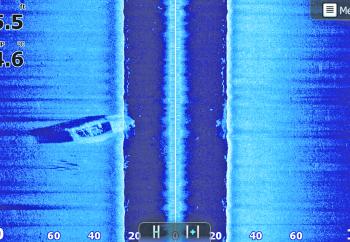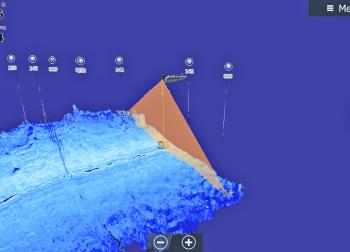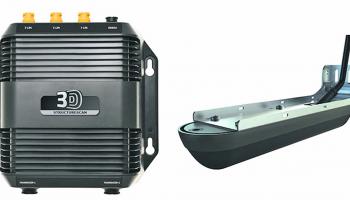It seems that almost yearly there are new advances in sonar technology. For long periods, small changes were the norm with nothing out of the ordinary coming out, that is to say, nothing mind-blowing. Now we are lucky enough to get to see exciting new products almost yearly!
Much like how smart phones develop, so is our fish finding technology! Some may call it an unfair advantage, but I think any advantage we can get over the fish is worth using. I enjoy catching fish! Having said that, this review is on a product that Navico (the parent company of Lowrance and Simrad) have recently launched – Structure Scan 3D.
So what do they mean by 3D? Well, firstly let’s go back one step. If you have any experience with fish finders over the past few years, you will have heard about or used or even owned a sounder with Side Scan capabilities. That is, a sounder that can scan either side of the boat, not just directly underneath.
These images appear flat as they are basically a floor plan view. There are cues you can use to gauge the depths and heights of objects, but for the most part, gaining information on the height of an object in the water column was achieved by going directly above.
Structure Scan 3D now adds the height aspect of what we see on Side Scan to help anglers better understand what is going on beneath us. As an example that I can easily relate to, as an architect, looking at floor plans of a house can only give you so much information. It is only once you read the floor plan in conjunction with the front and side views and 3D perspectives that you can fully understand and appreciate what it is you are looking at.
This is where structure scan 3D comes into its own. Anglers often struggle to grasp how to read the Side Scan images, as it can be tricky to understand the concept from just one image. The new 3D now makes things a little easier by putting the seabed and the boat into perspective, basically adding an extra view to help us understand.
As we drive around, we are given a 3D view of what is underneath and to the side of the boat. Any objects that protrude from the bottom will be easily detected. This is great for sounding reef or bommies.
Fish are also shown on 3D as small dots in the water column. We can now see how far away from the boat they are and in what depth of water they are sitting. These fish can be easily marked by touching the screen and creating a new waypoint.
To give you a bit of an idea, below are a few screen shots with some explanations of what you are looking at. These were taken on the Gold Coast.
Below is a typical image that Structure Scan 3D will display. The orange cone also known as the ‘Leading Edge’ shows the area that is currently being scanned. We can also see that any current waypoints we have will show up as we drive through the area. This is handy when you have marked a school of fish and are positioning the boat to anchor or drift through the school.
The next image was taken at the same time, although this time the screen was panned to change the direction of the view. We are able to move 180° around the boat to view from different angles.
The last image shows a view from behind the boat, on the left hand side we can see the structure coming up. This was actually a rocky reef that met with a sand edge. You can see the contoured ‘jagged’ nature of the bottom and where it meets with the flat ground.
The Structure Scan 3D is an addition to Lowrance HDS Gen3 and Simrad NSS Evo 2 models. It comprises of a Sonar Module and a new Transducer. This new transducer now has 7 elements as opposed to 3 in previous models. These now allow for greater coverage and clarity. Side Scan is now greatly enhanced, with the ability to scan more than double the area that we were previously able to.
The installation process is simple, fit the Lss3 (3D) transducer and plug it straight into the Sonar Module. The sonar module then connects to your HDS or Simrad unit. The sonar module will need to be powered and wired up to a power source.
It will be very interesting to see how anglers use this new technology to help them locate and catch more fish. For me, the enhanced Side Scan coverage and clarity is just mind-blowing. That in itself has made the upgrade worthwhile! It is only very new tech, and in it’s early days, so I’m sure there is still plenty to learn, it is definitely a handy tool to add to the arsenal and I’m looking forward to playing with it more.
Reads: 9213
A typical Side Scan image showing the left and right hand side of our boat. In this image we can see a boat wreck on the left hand side.

We can see the boat in the middle of the screen, this represents where we are. The cone is covering a large area to the left and right of the boat, this represents what we are scanning.

The new Structure Scan 3D Module and the new Transducer. Both similar to their predecessors. The new transducer is slightly deeper to include for the additional elements.

You can see the contoured ‘jagged’ nature of the bottom and where it meets with the flat ground.




